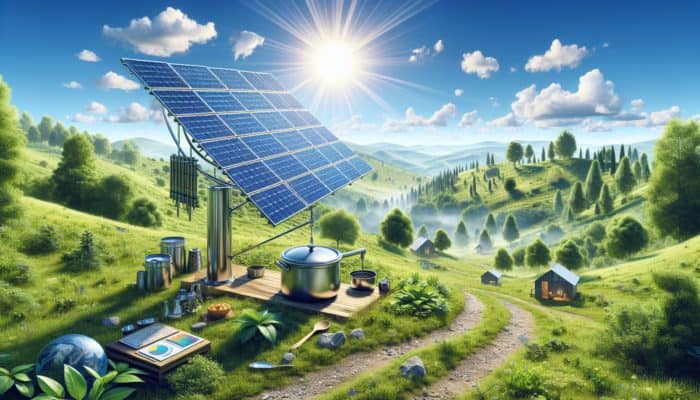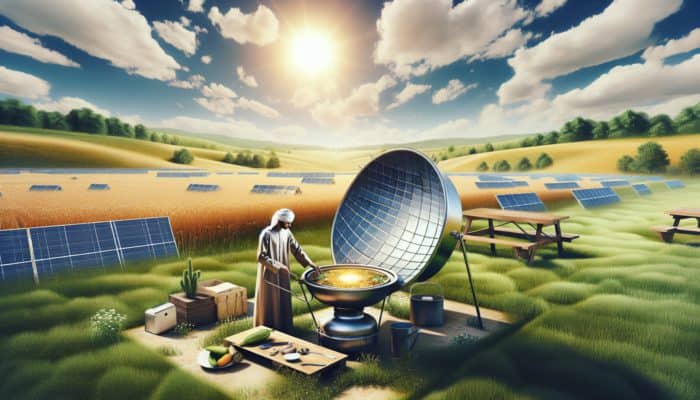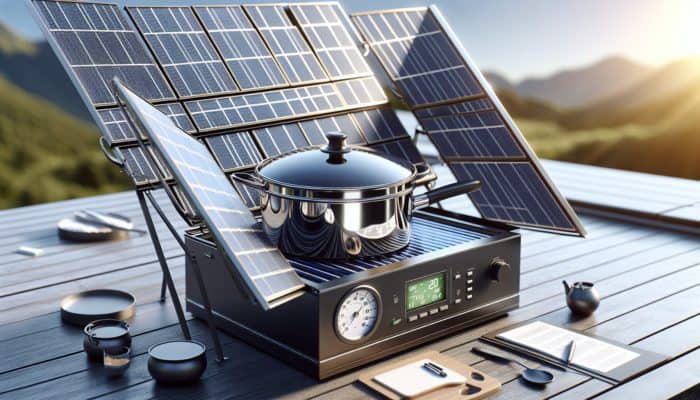Unlock the Advantages and Methods of Solar-Powered Cooking
Understanding Solar-Powered Cooking: Mechanisms and Benefits

Solar-powered cooking utilizes the vast energy provided by the sun to heat and prepare food, presenting a sustainable and eco-friendly alternative to conventional cooking methods. With the growing concerns surrounding climate change and an increasing demand for clean energy solutions, solar cooking stands out as a practical approach to lessening dependence on fossil fuels and curbing carbon emissions. This cooking method is especially beneficial in areas with limited or unreliable electricity access, offering an efficient way to prepare meals while harnessing a free and renewable resource. By embracing solar energy, we take a significant step toward a sustainable future while enjoying delicious, environmentally friendly meals.
Explore the Various Types of Solar Cookers and Their Uses
A range of solar cookers is available, each tailored to fulfill specific cooking needs and adapt to diverse environmental conditions. Familiarizing yourself with these different types will aid you in selecting the ideal solar cooker that aligns with your preferences and culinary goals.
- Box Cookers: These insulated boxes utilize flat reflective panels to concentrate sunlight into a cooking chamber, making them perfect for slow-cooking and baking tasks.
- Panel Cookers: Featuring reflective panels that funnel sunlight directly into a pot, panel cookers are lightweight and portable, making them an excellent choice for outdoor activities like camping.
- Parabolic Cookers: These cookers concentrate sunlight onto a single focal point, achieving high temperatures quickly, which makes them ideal for frying and boiling.
- Solar Ovens: Specifically designed for baking, these ovens can achieve higher temperatures and effectively handle a variety of dishes.
Selecting the right type of solar cooker hinges on several factors, including the specific meals you wish to prepare, your local climate, and the frequency of use. Each type offers unique benefits, unlocking a world of culinary possibilities powered solely by solar energy.
Explore the Compelling Reasons to Embrace Solar Cooking
Solar cooking provides a wealth of advantages that extend far beyond mere meal preparation. It embodies a sustainable practice that aids in environmental conservation while fostering a healthier lifestyle. Here are some of the most notable benefits:
- Energy Savings: Utilizing solar cooking reduces reliance on traditional energy sources, leading to lower utility bills and enhanced savings.
- Environmental Benefits: It helps decrease greenhouse gas emissions and diminishes air pollution, contributing to a cleaner atmosphere.
- Reliable Cooking During Power Outages: Solar cooking serves as a dependable method for meal preparation during emergencies when electricity may be unavailable.
- Promotion of Sustainable Practices: It encourages the adoption of renewable energy, nurturing a sense of responsibility towards the environment.
By choosing solar cooking, individuals not only support energy independence but also bolster community resilience, making it an ideal choice for families and individuals seeking a greener, more sustainable lifestyle.
Mastering the Effective Use of a Solar Cooker for Optimal Results

To use a solar cooker effectively, follow a few straightforward steps to ensure optimal performance and delightful culinary results. Begin by selecting a location that receives direct sunlight, ideally a spot that enjoys consistent sunlight throughout the cooking process. Securely set up your cooker, ensuring it is stable and correctly oriented to capture sunlight efficiently.
As you prepare your meal, periodically adjust the cooker’s angle to maintain direct exposure to the sun. Depending on the specific type of solar cooker, preheating may be necessary before placing your food inside, enhancing overall cooking efficiency.
Timing is also essential; solar cookers generally require longer cooking times compared to conventional methods due to their slower heat absorption. Keep a close watch on your food, using a thermometer to check for doneness, particularly with meats and baked goods. With practice, you will master the art of solar cooking, enjoying a diverse range of meals prepared using the sun’s energy.
Global Practices of Solar Cooking: A Worldwide Perspective
Solar cooking has gained international recognition, showcasing its versatility and adaptability across different environmental contexts. In rural regions of Africa, for example, communities have embraced solar cookers to reduce their dependence on firewood, leading to decreased deforestation and improved air quality.
Countries such as India and Brazil have initiated solar cooking programs in schools and community kitchens, demonstrating how solar cookers can effectively feed large populations. A notable initiative is the Solar Cooking Project in Rajasthan, India, where thousands of households have successfully integrated solar cookers, greatly improving their health while lowering household expenses.
Urban areas also benefit from solar cooking, with city residents utilizing rooftop gardens to harness solar energy for their cooking needs. These examples highlight the positive impact of solar cooking on local communities and the environment, paving the way for a sustainable future worldwide.
The Mechanisms of Solar Cooking: A Deep Dive into the Process
Exploring the Principles of Solar Energy Conversion for Cooking

Solar cooking operates based on the core principles of solar energy conversion, where sunlight is transformed into heat through reflective surfaces and insulated cooking chambers. The essential components of solar cookers include:
- Reflective Panels: These surfaces capture and direct sunlight towards the cooking area, maximizing heat absorption.
- Insulated Cooking Chamber: This chamber retains heat, ensuring that food cooks evenly and thoroughly throughout the cooking process.
- Cooking Pots: Dark-colored pots are preferred since they absorb more heat, enhancing the cooking process and overall efficiency.
- Thermometers: Crucial tools for monitoring internal temperatures and ensuring food safety during cooking.
The efficiency of solar cookers is largely dependent on their design, positioning, and the intensity of available sunlight. By effectively capturing solar energy, solar cookers can achieve cooking temperatures suitable for a wide variety of dishes, making them a viable option for sustainable cooking practices.
Strategies to Enhance the Efficiency of Solar Cooking
Maximizing the efficiency of solar cooking is vital for achieving the best culinary results. Position your cooker in an area that receives direct sunlight for prolonged periods, particularly during peak sunlight hours, to enhance its performance.
Utilizing dark-colored pots can significantly improve heat absorption; therefore, select cookware that optimizes thermal efficiency. Additionally, consider wind protection; utilizing a windbreak can help maintain consistent cooking temperatures, especially in breezy conditions, ensuring that your food cooks evenly.
Regular maintenance of your solar cooker is essential for ensuring optimal performance. Check for any signs of wear and tear, clean the reflective surfaces regularly to ensure maximum sunlight absorption, and store the cooker properly when not in use. By following these tips, you can elevate your solar cooking experience and explore numerous culinary possibilities.
Exploring the Versatility of Solar Cookers: What Dishes Can You Prepare?
Indeed, solar cookers are exceptionally versatile and can be used to create a wide range of dishes. From hearty stews and soups to baked goods like bread and cakes, the possibilities are virtually limitless.
However, it is important to remember that cooking times may vary significantly compared to traditional methods. Some recipes may require modifications to account for the slower cooking process of solar cookers. For instance, stews tend to benefit from prolonged, slow cooking to blend flavors beautifully, while baked goods may need specific adjustments to ingredient ratios and cooking times.
Experimentation is essential; begin with simple recipes and gradually introduce more complex dishes as you become familiar with your cooker’s performance and capabilities. This adaptability makes solar cooking not only practical but also an exciting culinary adventure filled with discovery and exploration.
Expert Tips for Mastering Solar Cooking Techniques and Best Practices
Insights from Seasoned Solar Cooks: Valuable Cooking Advice
Experienced solar cooks often possess a wealth of knowledge that can guide newcomers through the learning curve associated with solar cooking. A common piece of advice is to start cooking early in the day, as this allows ample time for meals to cook without the pressure of diminishing sunlight as the day goes on.
Experimentation is key; many seasoned cooks recommend trying various recipes and adjusting cooking times accordingly. For example, one solar cook in Australia shared her success in baking a cake using a box cooker, noting that preheating the cooker for about 30 minutes resulted in an even bake and delightful texture.
Keeping a cooking journal is also a beneficial practice; documenting what works and what doesn’t can lead to successful recipes over time. Additionally, joining online solar cooking communities can provide additional support and inspiration, allowing you to share your experiences and learn from others in the solar cooking realm.
Identifying Challenges in Solar Cooking: What to Expect
While solar cooking presents numerous advantages, it also comes with its own set of challenges. The most significant factor is reliance on weather conditions; overcast skies or rainy days can severely hinder cooking efforts and outcomes.
To effectively manage these challenges, it is advisable to have alternative cooking methods available, especially for individuals living in regions with unpredictable weather patterns. Moreover, planning meals for sunny days will maximize the benefits and effectiveness of solar cooking.
Longer cooking times can also be a challenge; understanding how to adjust recipes to accommodate the slower cooking process is crucial for success. Engaging with experienced solar cooks can provide practical solutions to common challenges, empowering you to optimize your solar cooking adventures and outcomes.
Essential Maintenance Tips for Your Solar Cooker: Expert Recommendations
Proper maintenance is critical to ensuring the longevity and optimal performance of solar cookers. Experts recommend several key practices to ensure your solar cooker functions effectively throughout its lifespan.
Start by routinely cleaning the reflective surfaces with a soft cloth to maintain maximum sunlight absorption. Additionally, inspect for any signs of wear and tear, particularly around hinges or seals, as these can significantly impact performance and cooking results.
When not in use, store your cooker in a cool, dry place away from direct sunlight to prevent material degradation over time. It’s also prudent to check the cooking pots for scratches or damage, as these can impede cooking efficiency. By following these steps, you can improve your solar cooker’s functionality and longevity, ensuring many successful cooking experiences in the future.
Key Benefits of Embracing Solar-Powered Cooking
Understanding Solar Cooking’s Environmental Impact
Solar cooking acts as a powerful tool in lowering greenhouse gas emissions, making it a vital component in the ongoing fight against climate change. By adopting solar energy, individuals can significantly reduce their dependence on non-renewable energy sources, thus contributing to a meaningful reduction in their carbon footprint.
As more individuals embrace solar cooking practices, the collective impact can yield substantial environmental benefits. For instance, communities that transition to solar cooking report fewer instances of deforestation, as the demand for firewood decreases considerably.
Moreover, solar cooking promotes cleaner air quality by eliminating the smoke produced by traditional cooking methods. This aspect is especially beneficial in developing nations, where indoor air pollution from cooking fuels poses severe health risks to vulnerable populations. Through solar cooking, individuals not only enhance their culinary experiences but also contribute to global efforts aimed at combating climate change and preserving the environment.
Health Benefits Linked to Solar Cooking Practices
Utilizing solar cookers can yield numerous health benefits, primarily by reducing indoor air pollution associated with conventional cooking methods. Traditional cooking fuels, such as wood and charcoal, emit harmful pollutants that can negatively impact respiratory health and overall well-being.
By transitioning to solar cooking, individuals can significantly improve air quality within their homes, resulting in healthier living environments for families. Furthermore, outdoor solar cooking encourages a more active lifestyle, allowing families to enjoy meals in natural settings, which can enhance mental well-being and foster family bonding.
Solar cooking also promotes safer food preparation practices, as the consistent heat generated can reduce the risk of bacterial contamination in foods. Encouraging a shift toward solar cooking can lead to improved health outcomes, particularly in communities where traditional cooking methods are prevalent.
Economic Advantages of Adopting Solar Cooking Practices
Solar cooking not only advances environmental sustainability but also presents significant economic benefits. By harnessing solar energy for culinary purposes, individuals can markedly reduce their energy expenses and lessen dependence on costly fuels.
For families in developing regions, solar cooking serves as a cost-effective alternative to purchasing firewood or kerosene, leading to considerable savings over time. These savings can be redirected toward other essential needs such as education, healthcare, or nutrition.
Additionally, solar cooking can stimulate local economies as communities embrace this sustainable practice. By investing in solar cookers, countries can promote local manufacturing and create jobs, thereby contributing to economic growth while fostering environmental stewardship.
Convenience and Versatility of Solar Cookers in Culinary Practices
Solar cookers are remarkably versatile, offering various cooking methods that enhance flexibility in meal preparation. From baking to slow cooking, solar cookers can cater to diverse culinary styles, making them suitable for a wide array of international cuisines.
The convenience of solar cookers lies in their portability and ease of use. Many models are lightweight, making it easy to carry them to outdoor events, camping trips, or picnics. This portability fosters outdoor cooking experiences, facilitating social gatherings and community bonding over meals prepared using the sun’s energy.
Moreover, the capacity to cook multiple dishes simultaneously adds to their convenience. For example, you can bake bread while simmering a delicious stew, effectively optimizing your time and resources. This versatility makes solar cookers an appealing choice for those looking to enhance their cooking repertoire sustainably while benefiting from solar energy.
Educational Opportunities Offered by Solar Cooking Practices
Solar cooking serves as an effective educational tool, fostering awareness and understanding of renewable energy sources among individuals. By engaging with solar cooking practices, individuals can learn about the principles of solar energy, energy conservation, and sustainability.
In educational settings, solar cookers can be incorporated into science curricula, providing hands-on learning experiences for students of all ages. For example, school projects can involve constructing simple solar cookers, allowing students to explore concepts of thermodynamics, energy transfer, and environmental science in a practical and engaging way. Furthermore, solar cooking workshops can promote community engagement, encouraging participants to share their experiences and learn from one another. This collaborative approach not only enhances culinary skills but also deepens understanding of sustainable practices, nurturing a generation that values environmental responsibility and proactive participation in climate solutions.
Essential Strategies for Successful Solar Cooking
How to Select the Ideal Solar Cooker That Meets Your Needs
Choosing the perfect solar cooker is crucial to maximizing your solar cooking experience. Begin by assessing your cooking needs; consider the types of meals you intend to prepare, as different cookers provide varying capabilities tailored to specific dishes.
Portability is another essential factor to consider. If you plan to travel or use your cooker at outdoor events, opt for a lightweight, foldable model that can be easily packed and transported. Cooking capacity is equally important; larger families or groups may require a cooker with a more extensive cooking area to efficiently accommodate multiple dishes.
Lastly, take your budget into account. While some solar cookers can be quite affordable, investing in a high-quality model can enhance longevity and efficiency over time. Researching reviews and seeking recommendations can greatly assist you in making an informed decision that best suits your lifestyle and culinary preferences.
Adapting Cooking Techniques for Optimal Solar Cooking Results
Cooking with solar cookers necessitates a shift in techniques compared to traditional methods. The key to success lies in embracing slow cooking; most solar cookers function effectively at lower temperatures over extended periods, which requires adjustments in your approach.
Preheating your solar cooker can also play a vital role in achieving optimal results. Allowing the cooker to warm up adequately before adding food can significantly enhance cooking efficiency and the overall outcome. Selecting the right cookware is equally important; opt for dark, heavy pots that retain heat well, maximizing the overall cooking process.
Incorporating techniques such as covering pots with lids helps trap heat and moisture, ensuring food cooks evenly and thoroughly. Flexibility with recipes is crucial; adjusting cooking times and methods can yield delicious outcomes that cater to the unique characteristics of solar cooking. Embracing these techniques can elevate your solar cooking experience into an enjoyable culinary journey.
Safety Guidelines When Using Solar Cookers: Essential Precautions
Safety is paramount when engaging in solar cooking practices. Always wear protective gloves when handling hot cookware, as solar cookers can reach high temperatures that may cause burns. Ensuring proper ventilation during the cooking process is also essential; if you’re using a solar oven, make sure it’s in a well-ventilated area to prevent overheating.
Position your solar cooker away from flammable materials to mitigate any risk of fire. It is also advisable to keep a fire extinguisher or a bucket of water nearby as a precautionary measure during the cooking process. Finally, always supervise children and pets around the cooker to ensure their safety throughout the cooking experience. By adhering to these safety measures, you can enjoy the numerous benefits of solar cooking while minimizing potential risks.
Envisioning the Future of Solar-Powered Cooking: Innovations Ahead
Emerging Developments in Solar Cooking Technology to Anticipate
The future of solar-powered cooking appears bright, driven by ongoing technological advancements that enhance efficiency and user-friendliness. Recent innovations have led to the creation of materials that improve heat retention while maintaining lightweight designs, facilitating portability for users.
New solar cooker models now come equipped with features like built-in thermometers and timers, enabling more precise cooking experiences. Ongoing research into high-efficiency reflective materials has also resulted in significant improvements in sunlight capture, rendering solar cooking more accessible and effective for a broader audience.
These advancements open exciting avenues for culinary creations, allowing users to explore diverse cooking styles with greater ease. As technology continues to evolve, solar cooking is poised to become an increasingly popular choice for environmentally conscious individuals and families seeking to embrace sustainable living practices.
Integrating Solar Cooking with Other Renewable Technologies: A Path to Enhanced Efficiency
The integration of solar cooking with other renewable energy technologies is emerging as a promising trend, enhancing the versatility and efficiency of solar-powered cooking solutions. For instance, combining solar cookers with photovoltaic systems can offer a more comprehensive energy solution, enabling users to harness solar energy for both cooking and electricity needs.
Furthermore, innovations such as solar thermal collectors can augment cooking processes by providing hot water for food preparation, further expanding the capabilities and functionalities of solar cookers. These integrations not only enhance efficiency but also advocate a holistic approach to sustainable living that encompasses multiple aspects of energy usage.
As communities increasingly adopt solar cooking alongside other green technologies, a more integrated and sustainable lifestyle can be achieved, paving the way for a future where renewable energy sources play a central role in our daily lives and culinary practices.
The Importance of Solar Cooking in Sustainable Living Practices
Solar cooking plays a crucial role in promoting sustainable living, marking a significant shift toward eco-friendly practices that reduce reliance on fossil fuels and other non-renewable energy sources. By adopting solar cooking, individuals actively contribute to reducing carbon emissions and advancing a cleaner, healthier environment for all.
Incorporating solar cooking into daily routines encourages communities to engage with renewable energy practices, fostering a culture of sustainability that can inspire future generations. Moreover, by utilizing solar cookers, families can enhance their energy independence, reducing reliance on external energy sources that may not be sustainable in the long term.
As more individuals embrace solar cooking, a ripple effect is created, inspiring others to consider how they can incorporate renewable energy into their daily lives. The collective impact of solar cooking can lead to transformative changes in energy consumption patterns, promoting a more sustainable lifestyle for current and future generations.
The Global Rise and Impact of Solar Cooking Initiatives
The global adoption of solar cooking is witnessing remarkable growth, with increasing recognition of its benefits in both developed and developing nations. In regions facing energy shortages, solar cookers provide a reliable and sustainable cooking solution, significantly influencing local communities and their culinary practices.
Countries such as Nepal and Kenya have embraced solar cooking as a means to mitigate deforestation and address the health risks linked to traditional cooking fuels. These initiatives not only improve energy access but also empower communities by reducing the time spent gathering firewood and other fuels.
As awareness spreads, solar cooking is becoming a vital component of global sustainability efforts. By decreasing carbon footprints and promoting cleaner cooking alternatives, solar cooking contributes to a more resilient and environmentally friendly future. The movement towards solar cooking exemplifies how simple innovations can lead to significant positive changes worldwide, fostering a sustainable and eco-conscious society.
Your Questions Answered: Frequently Asked Questions about Solar Cooking
What is a solar cooker?
A solar cooker is a device that uses sunlight to cook food by converting solar energy into heat, providing a sustainable alternative to traditional cooking methods while promoting eco-friendly practices.
Can I use any pot in a solar cooker?
While various pots can be used, it is advisable to select dark, heavy cookware that absorbs heat efficiently, enhancing the overall cooking process and results in solar cooking.
How long does it take to cook food in a solar cooker?
Cooking times can vary based on the type of food and the solar cooker’s efficiency; however, generally, expect longer cooking times compared to conventional cooking methods.
Can solar cookers work on cloudy days?
Solar cookers can operate on cloudy days, but their efficiency is significantly reduced. It is advisable to plan your cooking on sunny days for optimal results and performance.
How do I clean my solar cooker effectively?
To clean your solar cooker, gently wipe down the reflective surfaces with a soft cloth. Ensure that all cooking pots are thoroughly washed after each use to maintain hygiene and optimal performance.
Are solar cookers safe to use in the kitchen?
Yes, solar cookers are safe when used properly. Always use protective gloves when handling hot items and ensure the cooker is positioned away from flammable materials to mitigate risks.
Can I bake in a solar cooker?
Yes, many solar cookers are capable of baking bread, cakes, and other baked goods, making them versatile for various cooking methods and culinary styles.
What are the primary benefits of solar cooking?
The benefits of solar cooking encompass reduced energy costs, decreased environmental impact, improved air quality, and the ability to cook during power outages, making it a practical choice for many.
Do solar cookers require regular maintenance?
Yes, regular maintenance, such as cleaning reflective surfaces and checking for wear, is essential to ensure optimal performance, longevity, and reliability of solar cookers.
Where can I buy a solar cooker?
Solar cookers can be purchased online through various retailers or specialized eco-friendly stores, which typically offer a wide range of models to suit different needs and preferences.
Stay updated with our latest news and insights by visiting our Facebook page!
The post How to Cook with Solar-Powered Appliances: A Guide appeared first on https://cookinggods.com
The Article Solar-Powered Appliances: A Guide to Cooking Efficiently Was Found On https://limitsofstrategy.com

